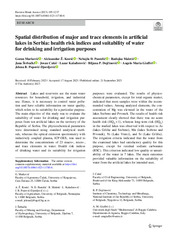Приказ основних података о документу
Spatial distribution of major and trace elements in artificial lakes in Serbia: health risk indices and suitability of water for drinking and irrigation purposes
| dc.creator | Marković, Goran | |
| dc.creator | Kostić, Aleksandar Ž | |
| dc.creator | Pantelić, Nebojša Đ | |
| dc.creator | Maletić, Radojka | |
| dc.creator | Štrbački, Jana | |
| dc.creator | Cakić, Jovan | |
| dc.creator | Kaluđerović, Lazar | |
| dc.creator | Dojčinović, Biljana P. | |
| dc.creator | Giuffrè, Angelo Maria | |
| dc.creator | Popović-Djordjević, Jelena B. | |
| dc.date.accessioned | 2023-10-31T09:26:18Z | |
| dc.date.available | 2023-10-31T09:26:18Z | |
| dc.date.issued | 2023 | |
| dc.identifier.issn | 1573-2959 | |
| dc.identifier.uri | http://www.ncbi.nlm.nih.gov/pubmed/37733141 | |
| dc.identifier.uri | http://aspace.agrif.bg.ac.rs/handle/123456789/6459 | |
| dc.description.abstract | Lakes and reservoirs are the main water resources for household, irrigation, and industrial use. Hence, it is necessary to control water pollution and have reliable information on water quality, which refers to its suitability for a particular purpose. The main objective of this study was to evaluate the suitability of water for drinking and irrigation purposes from ten artificial lakes on the territory of the Republic of Serbia. The physicochemical parameters were determined using standard analytical methods, whereas the optical emission spectrometry with inductively coupled plasma, ICP-OES, was used to determine the concentrations of 23 macro-, micro-, and trace elements in water. Health risk indices of drinking water and its suitability for irrigation purposes were evaluated. The results of physicochemical parameters, except for total organic matter, indicated that most samples were within the recommended values. Among analyzed elements, the concentration of Mg was elevated in the water of the lakes Srebrno and Prvonek. The results of health risk assessment clearly showed that there was no acute health risk (HQA < 1), whereas long-term risk (HQL) in the studied lakes was observed with respect to As (lakes Grlište and Srebrno), Mn (lakes Srebrno and Prvonek), Ni (Lake Vrutci), and Sr (Lake Grlište). The irrigation criteria indicated that the water from the examined lakes had satisfactory quality for this purpose, except for residual sodium carbonates (RSC). This criterion indicated low quality or unsuitability of the water in 7 lakes. The main outcomes provided valuable information on the suitability of water from the artificial lakes for intended uses. | |
| dc.language | eng | |
| dc.relation | info:eu-repo/grantAgreement/MESTD/inst-2020/200116/RS// | |
| dc.relation | info:eu-repo/grantAgreement/MESTD/inst-2020/200088/RS// | |
| dc.relation | info:eu-repo/grantAgreement/MESTD/inst-2020/200126/RS// | |
| dc.relation | info:eu-repo/grantAgreement/MESTD/inst-2020/200026/RS// | |
| dc.rights | openAccess | |
| dc.rights.uri | https://creativecommons.org/licenses/by/4.0/ | |
| dc.source | Environmental Monitoring and Assessment | |
| dc.source | Environmental Monitoring and AssessmentEnviron Monit Assess | |
| dc.subject | Cluster analysis | |
| dc.subject | Environmental Monitoring | |
| dc.subject | GIS | |
| dc.subject | Health risk | |
| dc.subject | Industry | |
| dc.subject | Irrigation | |
| dc.subject | Lakes | |
| dc.subject | Potentially toxic elements | |
| dc.subject | Reservoirs | |
| dc.subject | Serbia | |
| dc.subject | Trace Elements | |
| dc.title | Spatial distribution of major and trace elements in artificial lakes in Serbia: health risk indices and suitability of water for drinking and irrigation purposes | |
| dc.type | article | en |
| dc.rights.license | BY | |
| dc.citation.issue | 10 | |
| dc.citation.spage | 1237 | |
| dc.citation.volume | 195 | |
| dc.identifier.doi | 10.1007/s10661-023-11740-6 | |
| dc.identifier.fulltext | http://aspace.agrif.bg.ac.rs/bitstream/id/24893/Spatial_distribution_of_pub_2023.pdf | |
| dc.type.version | publishedVersion |


